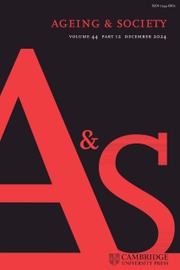Crossref Citations
This article has been cited by the following publications. This list is generated based on data provided by
Crossref.
Fotoglou, Apostolia
2020.
First steps in setting up a music group on a dementia ward.
FPOP Bulletin: Psychology of Older People,
Vol. 1,
Issue. 152,
p.
57.
Mittner, Lilli
Dalby, Karoline
and
Gjærum, Rikke Gürgens
2021.
Re-conceptualizing the gap as a potential space of becoming: Exploring aesthetic experiences with people living with dementia.
Nordic Journal of Arts, Culture and Health,
Vol. 3,
Issue. 1-2,
p.
63.
Strohmaier, Sarah
Homans, Karl M.
Hulbert, Sabina
Crutch, Sebastian J.
Brotherhood, Emilie V.
Harding, Emma
and
Camic, Paul M.
2021.
Arts-based interventions for people living with dementia: Measuring ‘in the moment’ wellbeing with the Canterbury Wellbeing Scales.
Wellcome Open Research,
Vol. 6,
Issue. ,
p.
59.
Camic, Paul M.
Dickens, Laura
Zeilig, Hannah
and
Strohmaier, Sarah
2021.
Subjective wellbeing in people living with dementia: exploring processes of multiple object handling sessions in a museum setting.
Wellcome Open Research,
Vol. 6,
Issue. ,
p.
96.
Camic, Paul M.
Dickens, Laura
Zeilig, Hannah
and
Strohmaier, Sarah
2021.
Subjective wellbeing in people living with dementia: exploring processes of multiple object handling sessions in a museum setting.
Wellcome Open Research,
Vol. 6,
Issue. ,
p.
96.
Quail, Zara
Bolton, Laura
and
Massey, Karina
2021.
Digital delivery of non-pharmacological intervention programmes for people living with dementia during the COVID-19 pandemic.
BMJ Case Reports,
Vol. 14,
Issue. 6,
p.
e242550.
Strohmaier, Sarah
Homans, Karl M.
Hulbert, Sabina
Crutch, Sebastian J.
Brotherhood, Emilie V.
Harding, Emma
and
Camic, Paul M.
2021.
Arts-based interventions for people living with dementia: Measuring ‘in the moment’ wellbeing with the Canterbury Wellbeing Scales.
Wellcome Open Research,
Vol. 6,
Issue. ,
p.
59.
Strohmaier, Sarah
Homans, Karl M.
Hulbert, Sabina
Crutch, Sebastian J.
Brotherhood, Emilie V.
Harding, Emma
and
Camic, Paul M.
2021.
Arts-based interventions for people living with dementia: Measuring ‘in the moment’ wellbeing with the Canterbury Wellbeing Scales.
Wellcome Open Research,
Vol. 6,
Issue. ,
p.
59.
Opgenhaffen, Tim
Put, Johan
Lepeleire, Jan De
Keady, John
and
Swinnen, Aagje
2022.
Dementia and Society.
p.
211.
Flynn, Aisling
Healy, David
Barry, Marguerite
Brennan, Attracta
Redfern, Sam
Houghton, Catherine
and
Casey, Dympna
2022.
Key Stakeholders’ Experiences and Perceptions of Virtual Reality for Older Adults Living With Dementia: Systematic Review and Thematic Synthesis.
JMIR Serious Games,
Vol. 10,
Issue. 4,
p.
e37228.
Fleetwood-Smith, Rebecka
Tischler, Victoria
and
Robson, Deirdre
2022.
Using creative, sensory and embodied research methods when working with people with dementia: a method story.
Arts & Health,
Vol. 14,
Issue. 3,
p.
263.
D’Andrea, Federica
Dening, Tom
Tischler, Victoria
and
Albert, Steven M
2022.
Object Handling for People With Dementia: A Scoping Review and the Development of Intervention Guidance.
Innovation in Aging,
Vol. 6,
Issue. 5,
Dowlen, R.
and
Keady, J.
2022.
Palgrave Encyclopedia of the Health Humanities.
p.
1.
Hodgson, James
and
Balmer, Andrew
2022.
Lying and Time: Moving beyond the Moral Question of Lying.
Sociology,
Vol. 56,
Issue. 5,
p.
983.
Campbell, Sarah
Dowlen, Robyn
and
Fleetwood-Smith, Rebecka
2023.
Embracing Complexity Within Creative Approaches to Dementia Research: Ethics, Reflexivity, and Research Practices.
International Journal of Qualitative Methods,
Vol. 22,
Issue. ,
Jiang, Zhanhao(House)
2023.
Book Review: Dementia Caregiving East and West: Issues of Communication.
Dementia,
Vol. 22,
Issue. 5,
p.
1199.
Engineer, Margi
Kot, Sushant
and
Dixon, Emma
2023.
Investigating the Readability and Linguistic, Psychological, and Emotional Characteristics of Digital Dementia Information Written in the English Language: Multitrait-Multimethod Text Analysis.
JMIR Formative Research,
Vol. 7,
Issue. ,
p.
e48143.
Huizenga, Jacoba
Scheffelaar, Aukelien
Bleijenberg, Nienke
Wilken, Jean Pierre
Keady, John
and
Van Regenmortel, Tine
2023.
What matters most: Exploring the everyday lives of people with dementia.
International Journal of Geriatric Psychiatry,
Vol. 38,
Issue. 8,
Elsden, Esme
Kador, Thomas
Sercombe, Hannah
Piper, Kim
Barkan, Melissa
Webster, Emma
and
Smyth Zahra, Flora
2023.
Experiential learning spaces and student wellbeing: a mixed-methods study of students at three research intensive UK universities.
International Review of Psychiatry,
Vol. 35,
Issue. 7-8,
p.
591.
Camic, Paul M.
Sullivan, Mary Pat
Harding, Emma
Gould, Martha
Wilson, Lawrence
Rossi-Harries, Sam
Grillo, Adetola
McKee-Jackson, Roberta
Cox, Susan M.
Stott, Joshua
Brotherhood, Emilie V.
Windle, Gill
and
Crutch, Sebastian J.
2024.
‘Misdiagnosed and Misunderstood’: Insights into Rarer Forms of Dementia through a Stepwise Approach to Co-Constructed Research Poetry.
Healthcare,
Vol. 12,
Issue. 4,
p.
485.

